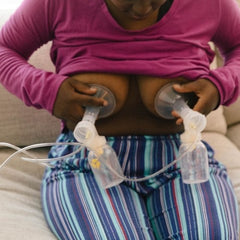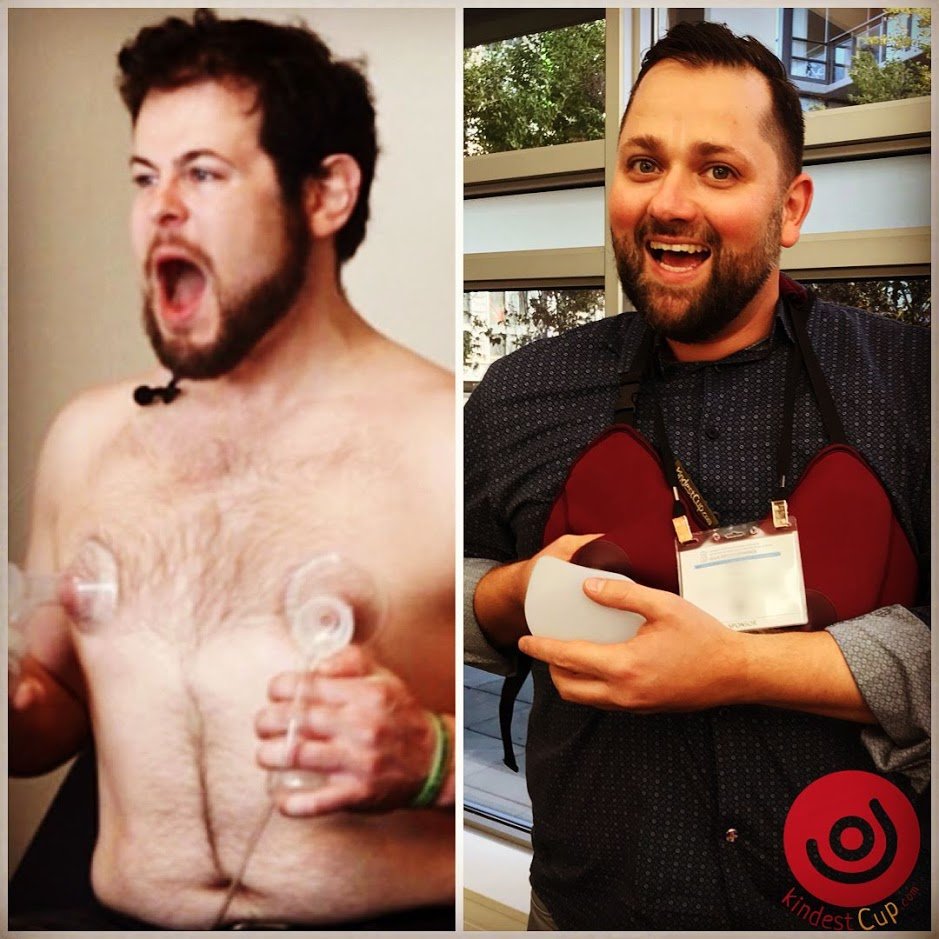There are several ways to remove breast milk from a lactating breast. For humans, evolution equipped us with two main methods: breastfeeding and hand expression.


Some other mammals don't do hand expression but they can reach their breasts/ teats with their own mouth and remove milk that way. That's not really an option for most of us...

In recent times, we have added another option: mechanical breast pumps.

Clearly, it is a good idea to have a backup system for milk removal. That way, mother and baby can survive a planned or unexpected temporary separation without compromising milk supply.
But do we need two back up systems: hand expression and pumping? Aren't breast pumps and hand expression doing the same thing? Do we even still need hand expression?
The answer is that hand expression and pumping are based on fundamentally different mechanisms and many of us will still benefit from hand expression.
Below, I will discuss differences and similarities between hand expression and pumping from a mechanical perspective.
Mechanics: Push vs Pull
In order for a liquid or gas to move in a certain direction, there needs to be a pressure gradient. For breast milk to move out of the breast the pressure inside the breast needs to be higher than outside of the breast. Hand expression increases the pressure inside the breast by compressing the alveoli that hold the milk and hence, pushing it into the ducts and towards the openings in the nipple. Pumping decreases the pressure outside the breast by creating a vacuum at the nipple. This is called suction. As a result, milk is pulled out of the ducts and alveoli. Although the end result is the same, milk coming out of the breast, the underlying mechanisms are different.
In the video below, I illustrate the difference between compression and suction when it comes to removing the air from an exercise ball.
As you can see, suction with a pump takes longer than compression to move the same amount of air. That's because compression can be applied continuously and can be targeted at the right spots while the pump only applies suction for a part of it's duty cycle and only at the opening of the ball.
So how do hand expression and pumping compare to breastfeeding? A breastfeeding baby uses both, compression and suction. Baby compresses the breast and pushes out milk with its chin and jaw (and sometimes even with it's hands) and it also sucks out milk by generating negative pressure in the oral cavity.
Below is a clip showing an experienced nursling using suction and hand expression.
Efficiency: breastfeeding vs. hand expression vs. pumping
Since breastfeeding uses both, compression and suction, it is the most efficient way to express breastmilk.
Hand expression is (at present) the second most efficient way. Although it only uses compression, it can be applied consistently and at different areas and angles to effectively push milk towards the nipple.
Pumping is (at present) the least effective way to remove milk. It relies on suction, which can only be applied at the nipple, and most pump have a 'duty cycle' which only applies suction for part of the time. The suction force that draws out the milk has to work its way up through tiny holes and ducts all the way back to the alveoli. Newer electric pumps try to compensate for this mechanical disadvantage by including a setting that is supposed to stimulate a letdown. During a letdown, cells around the alveoli contract and create compression that actively pushes the milk out.
Unfortunately, stimulating a letdown doesn't always work 'on demand' and some people are disappointed by the milk output they get from the pump. Although pump output is not a reflection of milk production, they try to increase their milk output by increasing the suction beyond a comfortable level that can be tolerated by the tissue. This can result in nipple damage.
Innovations in breast pumps: combining suction and compression
Notice that I said that pumping is least effective AT PRESENT. Interestingly, there have been attempts to create a pump that combines compression and suction (i.e. Kohana pump, or this experimental pump from Russia). Potentially, a pump like that could be almost as effective as baby feeding at the breast. Unfortunately, due to the way pumps are regulated as medical devices, it is incredibly expensive to develop and commercialize a novel, innovative breast pump. And existing players have little interest in disrupting a market that is literally their 'cash cow'. (A good read: Why Have So Many Breast Pump Startups Flamed Out? ). Also, there might be some reluctance on the part of the users to embrace a machine that squeezes your breasts...
Hands-on pumping to maximize milk output and fat content.
For now, the best way to empty a breast and get out the most milk without the help from a baby is to pump AND hand express. This can be done simultaneously or sequentially. There is scientific evidence that suggests that 'hands-on' pumping increases milk output by 48%.
Note that milk is a non-homogenous liquid. If you let breast milk stand for a while, you'll see it separate into a milky and a fatty fraction. In contrast, the air in the exercise ball in the demo above is homogenous. How does the non-homogenous nature of breast milk affect the mechanics of compression and suction?
With compression, the milk gets swirled around and mixed up in the alveoli and both, fatty and watery fractions are moved towards the opening in the nipple.
With suction, however, the fraction with the lowest resistance to displacement will be drawn out first. That's the watery fraction, because it has a lower viscosity than the fatty fraction. That means that there is a potential risk of leaving behind fatty milk in the breast, which can result in less energy-rich nutrition for baby and increased risk of clogged ducts for the breastfeeding parent.
I'm wondering if the whole fore milk/ hind milk debate might be an artefact of using breast pumps and not necessarily applicable to breastfeeding or hand expression.

Comfort and convenience
If you're not as concerned about maximizing milk output but more about maintaining breast comfort and general convenience, pumping and hand expression both have their pros and cons. Pumping can be done hands-free. But it requires a relatively bulky pump, assembly and cleaning of multiple pump parts etc. It takes more time because it's less efficient, as discussed above. In my opinion, the ideal use case for a pump is when you can sit back, relax, watch your favorite show while pump does the rest. My advice: try to avoid pumping when you're in a rush because your breast might have different plans and not getting any milk when you need it quickly feels terrible!

For hand expression all you need is your hands. You don't need to put together a machine or remember to bring anything if you're out and about... it is a bit more work for your hands than pumping but it can be done anywhere, in practically any situation. If you need to take off some pressure from full breasts you don't have to wait and suffer until you can pump... you can hand express in into a sink, on the side for the road, anywhere... Even better: you can hand express into a receptacle and save the milk. Best: you can use an ergonomic receptacle like kindestCup to make the work easy on your arms and hands. Hand expression gives you a ton of flexibility and self-sufficiency. This is really important! The constant need for managing milk supply can be overwhelming, to the point where it can make you feel trapped. With hand expression, you can literally take milk management in your own hands and do more while worrying less.





